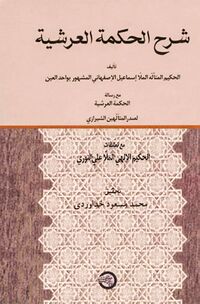Isma'il Darbkushki Isfahani
| Personal Information | |
|---|---|
| Birth | unknown |
| Residence | Isfahan |
| Studied in | Isfahan |
| Death | about 1240/1824-5 |
| Burial Place | Takht-i Fulad Cemetery, Isfahan |
| Scholarly Information | |
| Professors | Mulla Ali Nuri |
| Students | Mulla Hadi Sabziwari, Sayyid Ali Hakim, etc. |
| Works | Glosses on Al-Asfar, Masha'ir etc. |
Mullā Ismāʿīl b. Muḥammad Samīʿ Darbkūshkī Isfahānī (Persian: اسماعیل بن محمدسمیع درب کوشکی اصفهانی) (d. about 1240/1824-5), known as Wāḥid al-ʿAyn, was a philosopher and a teacher of philosophy and theology of 13th/19th century. He was a student of Mulla 'Ali Nuri. Mulla Hadi Sabziwari is one of his eminent students. Works such as: al-Hikmat al-'arshiyya and gloss on al-Asfar (written by Mulla Sadra) have remained from him.
His participation along with his students in Mulla 'Ali Nuri's class is counted as his notable characteristic.
Birth
His birth date is not known. Little information has been reported from his life in biographical books.
He was nicknamed Wahid al-'ayn (one-eyed) because one of his eyes was visually impaired. However, Mulla Hadi Sabziwari nicknamed him as Dhu l-'Uyun (who has eyes) or Dhu l-'Aynayn (who has two eyes) because he had open eyes in both intellectual and narrative sciences.
Education
Mulla Isma'il was a student of Mulla 'Ali Nuri in philosophy. Even after he became an undisputed teacher in philosophy; he and his students participated in Mulla 'Ali Nuri's class to honor and respect him.
Also, he was Shaykh Ahmad Ahsa'i's contemporary. He attended Ahsa'i's sessions once and defeated him in a debate about knowledge.
Students
Mulla Isma'il's students, who participated in Mulla 'Ali Nuri's class, preferred Mulla Isma'il's philosophy class; because he was explicit and eloquent in his speech and used verses of the Qur'an, hadiths, and poems to explain the topics and convince his students. On the other hand, Mulla 'Ali –especially at the end of his life- was more cautious in his philosophy class and avoided explicit explanation of topics and subjects.
It should be pointed out, that there is one of his students with exactly the same name "Isma'il Darbkushki Isfahani". Some have considered them as one person due to this similarity, but the student was a son of Muhammad Ja'far while the teacher is a son of Muhammad Sami'; also the student passed away in 1304/1887 while the demise of the teacher is reported decades earlier.
Works

He has written glosses on important philosophical and theological books, such as:
- Glosses on al-Asfar, Masha'ir, Shawariq al-ilham.
- Glosses under the name of Mulla Isma'il Isfahani on Jamal al-Din Khwansari glosses on Hashiyat Khafri have been attributed to him.
- Commentary on al-Hikmat al-'arshiyya (written by Mulla Sadra): in this commentary, he answered al-Ahsa'i's questions and believed that they were rooted in his wrong comprehension of the book. In this work, he has explained what the author meant by intellectual and narrative proofs and evidences.
- Several Persian treatises in mysticism and philosophy (some of which are: Wahdat al-Wujud, Jabal Qaf and Nawm al-mala'ika ) is attributed to him.
Demise
There are different reports about his demise date. Some say that he passed away after Mulla 'Ali Nuri (d. 1246/1831) in 1271/1854-5 or 1277/1860-1 or 1281/1864-5, but all of these dates are just guesses and assumptions without any definitive evidence. Sayyid Jalal al-Din Ashtiyani apparently by referring to Sabziwari's son-in-law, and also according to his teachers that Mulla Isma'il was in Tehran while Mulla 'Abd Allah Zunuzi (d. 1257/1842) was alive, came to this conclusion that Mulla Isma'il was certainly alive in 1267/1850-1.
However, what Mulla Hadi Sabziwari has said in his autobiography is noteworthy. He said that after the demise of Mulla Isma'il he studied philosophy for three years under Mulla 'Ali Nuri. According to this, one can conclude that Mulla Isma'il passed away in 1239/1824 or 1240/1824-5, a few years before Mulla 'Ali Nuri's demise.
References
- The material for writing this article was mainly taken from اسماعیل درب کوشکی اصفهانی in Farsi WikiShia.
